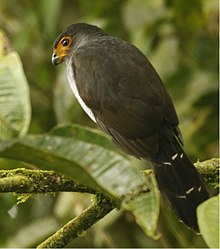The lined forest falcon (Micrastur gilvicollis) is a species of bird of prey in subfamily Herpetotherinae of family Falconidae, the falcons and caracaras. It is found in Bolivia, Brazil, Colombia, Ecuador, French Guiana, Guyana, Peru, Suriname, and Venezuela.[2][3]
| Lined forest falcon | |
|---|---|

| |
| Immature bird with brown iris and yellow face | |
| Scientific classification | |
| Domain: | Eukaryota |
| Kingdom: | Animalia |
| Phylum: | Chordata |
| Class: | Aves |
| Order: | Falconiformes |
| Family: | Falconidae |
| Genus: | Micrastur |
| Species: | M. gilvicollis
|
| Binomial name | |
| Micrastur gilvicollis (Vieillot, 1817)
| |

| |
Taxonomy and systematics
editUntil 1972 what is now the lined forest falcon was considered a subspecies of the barred forest falcon (M. ruficollis); the treatment as a full species was confirmed in 2019.[4][5] (In the mid-20th century some previous authors had treated it as a species.) What is now the cryptic forest falcon (M. mintoni) was a population of the lined forest falcon until 2002 when vocal studies and specimen analyses determined it was a separate species.[6] The plumbeous forest falcon (M. plumbeus) has sometimes been considered a subspecies of the lined forest falcon.[7]
Description
editThe lined forest falcon is 33 to 38 cm (13 to 15 in) long and weighs 170 to 262 g (6.0 to 9.2 oz). It has pale gray upperparts. Its white underparts have highly variable gray barring, from light gray only on the breast to heavy bars on the entire underparts. Its tail is dark gray with a white tip and two narrow white bars. Its iris is white surrounded by bare reddish orange skin and its legs and feet are yellow.[8]
Distribution and habitat
editThe lined forest falcon is found in the Amazon Basin from eastern Colombia, eastern Ecuador, eastern Peru, and northern Bolivia east through Venezuela, the Guianas, and northern Brazil to the Atlantic coast. It mostly inhabits the interior of intact tropical primary forest, though it occurs in lower density in secondary forest and forest edges. In Colombia and Ecuador it prefers terra firme forest. In elevation it ranges from near sea level to 1,600 m (5,200 ft).[8]
Behavior
editMovement
editAs far as is known the lined forest falcon is a year-round resident throughout its range.[8]
Feeding
editThe lined forest falcon hunts mostly in the forest understorey. Its diet has not been described in detail but is known to include lizards, large insects, birds, snakes, and small mammals. It sometimes follows army ant swarms.[8]
Breeding
editEssentially nothing is known about the lined forest falcon's breeding biology. It is probably similar to that of the barred forest falcon, which see here.[8]
Vocalization
editThe lined forest falcon's most common vocalization is a series of "nasal "cow-káh", "cow káw-káw" or "cow káw-káw-káw""notes. It typically calls before dawn and during wet weather.[9][8]
Status
editThe IUCN has assessed the lined forest falcon as being of Least Concern. It has a large range, but its population size is not known and is believed to be decreasing. No immediate threats have been identified.[1] It is thought to be "the most abundant diurnal raptor over much of lowland forest of Amazonia, where it attains very high densities".[8]
References
edit- ^ a b BirdLife International (2016). "Lined Forest-falcon Micrastur gilvicollis". IUCN Red List of Threatened Species. 2016: e.T22696281A93553538. doi:10.2305/IUCN.UK.2016-3.RLTS.T22696281A93553538.en. Retrieved 11 February 2023.
- ^ a b Gill, F.; Donsker, D.; Rasmussen, P., eds. (January 2023). "Seriemas, falcons". IOC World Bird List. v 13.1. Retrieved February 11, 2023.
- ^ Remsen, J. V., Jr., J. I. Areta, E. Bonaccorso, S. Claramunt, A. Jaramillo, D. F. Lane, J. F. Pacheco, M. B. Robbins, F. G. Stiles, and K. J. Zimmer. 30 January 2023. Species Lists of Birds for South American Countries and Territories. https://www.museum.lsu.edu/~Remsen/SACCCountryLists.htm retrieved January 30, 2023
- ^ Schwartz, P. (1972). "Micrastur gilvicollis, a valid species sympatric with M. ruficollis in Amazonia" (PDF). Condor. 74 (4): 399–415. doi:10.2307/1365892. JSTOR 1365892. Retrieved February 11, 2023.
- ^ Dos Santos Soares, L.M.; Bates, J.; Carneiro, L.S.; Dantas Santos, M.P.; Aleixo, A. (2019). "Molecular systematics, biogeography and taxonomy of forest-falcons in the Micrastur ruficollis species complex (Aves: Falconidae)". J. Avian Biol.: e01943.
- ^ Whittaker, A. (2002). "A new species of forest-falcon (Falconidae: Micrastur) from southeastern Amazonia and the Atlantic rainforests of Brazil". Wilson Bulletin. 114 (4): 421–445. doi:10.1676/0043-5643(2002)114[0421:ANSOFF]2.0.CO;2. S2CID 55356779.
- ^ Remsen, J. V., Jr., J. I. Areta, E. Bonaccorso, S. Claramunt, A. Jaramillo, D. F. Lane, J. F. Pacheco, M. B. Robbins, F. G. Stiles, and K. J. Zimmer. Version 30 January 2023. A classification of the bird species of South America. American Ornithological Society. https://www.museum.lsu.edu/~Remsen/SACCBaseline.htm retrieved January 30, 2023
- ^ a b c d e f g Bierregaard, R. O., P. F. D. Boesman, and J. S. Marks (2020). Lined Forest-Falcon (Micrastur gilvicollis), version 1.0. In Birds of the World (J. del Hoyo, A. Elliott, J. Sargatal, D. A. Christie, and E. de Juana, Editors). Cornell Lab of Ornithology, Ithaca, NY, USA. https://doi.org/10.2173/bow.liffal1.01 retrieved February 11, 2023
- ^ Klein, Bert C.; Bierregaard, Richard O. (May 1988). "Movement and Calling Behavior of the Lined Forest-Falcon (Micrastur gilvicollis) in the Brazilian Amazon". Condor. 90 (2): 497–499. doi:10.2307/1368582. ISSN 1938-5129. JSTOR 1368582.
